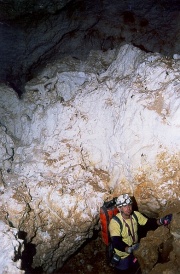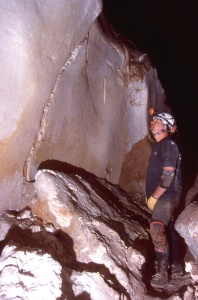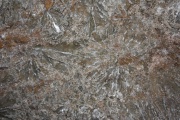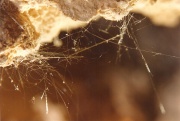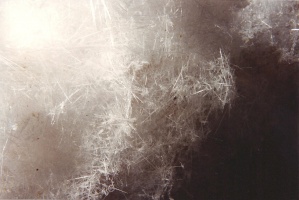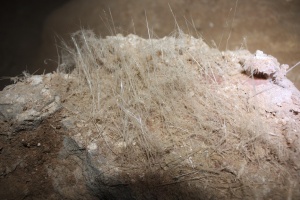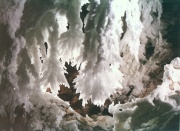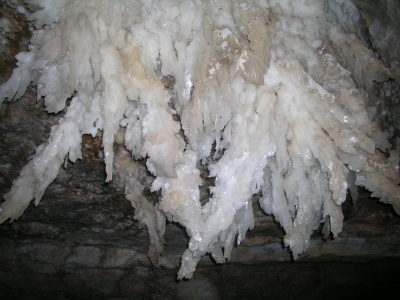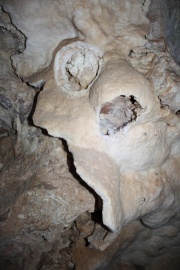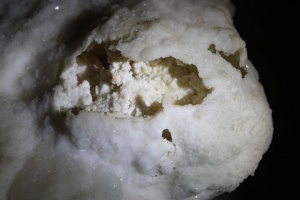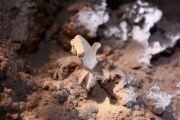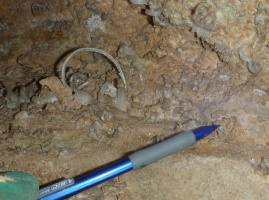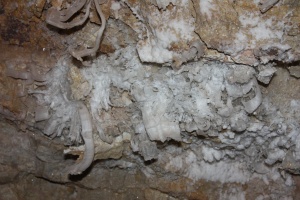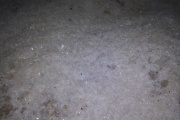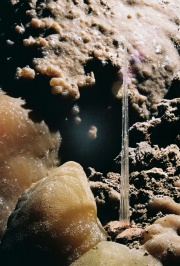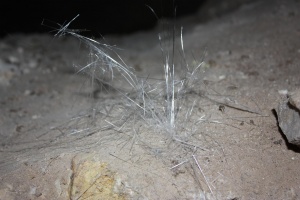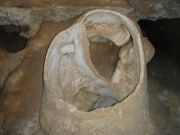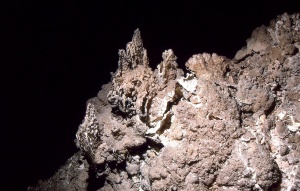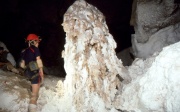Gypsum (Inventory)
From LagWiki
Beds, Massive
The Beds, Massive field of the Gypsum section should be used to record stations where massive gypsum is found.
In sulfuric acid caves, gypsum can accumulate in large, massive deposits. These deposits can appear as blocks on the cave floor. They are white in color but can be discolored and obscured by sediments, guano and other things.
Drip pits and rillenkarren can be associated with these massive gypsum beds.
References
- Palmer, Arthur N. (2007) Cave Geology CAVE BOOKS, Dayton, OH pp 215-225, especially 220 ISBN-13: 978-0-939748-66-2, ISBN-10: 0-939748-66-5
Beds, Massive, Gypsum
Coating
The Coating field of the Gypsum section should be used to list stations where a coating of gypsum is found.
A gypsum coating is a thin layer or layers of gypsum usually over bedrock or breakdown. It sometimes appears in star-like patterns but can take on many shapes. It can form on soils or even guano but is usually on rock. It is much thinner than a gypsum crust and more tightly adhered to the underlying structure. The distinctions between a gypsum coating and a gypsum crust may be subtle.
Gypsum sometimes makes starbursts while calcite tends to have squarish crystals. Aragonite and moonmilk are both bright white. Coatings may build up in layers, coating upon coating, to form thicker coatings.
See also
References
- Hill, Carol; Paolo Forti (1997) Cave Minerals of the World (Second Edition ed.) National Speleological Society pp 55-56, 145 ISBN: 1-879961-07-5
Cotton/Hair
The Cotton/Hair field of the Gypsum section should be used to record any observation of fibrous forms of gypsum.
Fibrous forms of gypsum are known by several descriptive names depending upon the appearance. These include: cotton, hair, beards, ropes, wool and others. All of the fibrous forms are closely related and should be inventoried in this field. Needles and flowers have their own fields.
The fibrous forms of gypsum are among the most delicate of speleothems. They appear as fine threads of gypsum, sometimes individually and sometimes in clusters or even coils like ropes. They can be found hanging from ceiling, growing from the walls, on ledges or on the floor especially in damp mud.
Fibrous gypsum is very fragile and even disturbance of the air from a passing caver or breath can damage them.
Look for the fibrous forms of gypsum anywhere gypsum may be present. Be sure to look under breakdown especially if the floor sediments are moist. Take great care not to damage them.
See also
References
- Hill, Carol; Paolo Forti (1997) Cave Minerals of the World (Second Edition ed.) National Speleological Society pp 66-68 ISBN: 1-879961-07-5
- Palmer, Arthur N. (2007) Cave Geology CAVE BOOKS, Dayton, OH pp 290-291 ISBN-13: 978-0-939748-66-2, ISBN-10: 0-939748-66-5
Cotton/Hair, Gypsum
Chandelier
The Chandelier field should be used to record stations that exhibit gypsum chandeliers.
Chandeliers are easily the most impressive of gypsum formations. They hang downward from the ceiling or outward from the wall in cascading, branching arrays of white gypsum. The arms may branch in various directions but tend downward. The arms are usually more massive at the base and thin as each branch occurs often terminating in selenite needles. If still active, drops of water may be visible at the tips. If inactive, it may be coated with a fine, white gypsum powder. The arms are often described as being claw-like or dagger-like. Chandeliers can vary in size and can be quite large. Large epsomite formations can sometimes be confused with gypsum chandeliers.
References
- Palmer, Arthur N. (2007) Cave Geology CAVE BOOKS, Dayton, OH pp 291-292 ISBN-13: 978-0-939748-66-2, ISBN-10: 0-939748-66-5
Chandelier, Gypsum
Crust
The Crust field of the Gypsum section should be used to list stations where a crust of gypsum is observed.
A gypsum crust is a poorly adhered layer of gypsum usually over bedrock or breakdown. Often there will be noticeable space between the crust and the structure that it covers. It usually appears as white, crystaline layer but may be discolored by dirt, dust or any number of other stains. Gypsum crusts can vary in thickness from a millimeter up to a half meter thick and can have the appearance of snow packed against the bedrock.
Gypsum crusts are often very fragile, brittle and easily broken if touched and though they sometimes appear substantial, they are not. The primary distinction between a gypsum crust and a gypsum coating is that a crust is less firmly adhered to the substructure.
See also
References
- Palmer, Arthur N. (2007) Cave Geology CAVE BOOKS, Dayton, OH pp 289-290 ISBN-13: 978-0-939748-66-2, ISBN-10: 0-939748-66-5
Crust, Gypsum
Crystal
The Crystal subsection of the Gypsum section is used to record appearances of crystal gypsum. Specific types should be recorded in the appropriate field.
Fields
Flower
The Flower field is used to record stations where gypsum flowers are found.
Gypsum flowers form when pyrite oxidizes just below the surface of exposed bedrock. They grow outward in curving fronds that appear to have been squeezed out of the rock like toothpaste. They form fronds which curl and separate, spreading to make something that resembles a flower. They are usually dry and white in color but can be stained, particularly with rust colors. Gypsum flowers are usually tiny to small but they can grow to be large with fronds of several feet. The diameter of each frond can vary from tiny to several inches on larger flowers. Gypsum flowers sometimes appear as single fronds, so the flower-like shape is not a requirement. Look for gypsum flowers with careful and close examination of all surfaces, especially exposed bedrock, breakdown and soils which might be just a thin layer over bedrock. Also look for them among gypsum crusts as they often occur together.
See also
References
- Palmer, Arthur N. (2007) Cave Geology CAVE BOOKS, Dayton, OH p 291 ISBN-13: 978-0-939748-66-2, ISBN-10: 0-939748-66-5
- Hill, Carol; Paolo Forti (1997) Cave Minerals of the World (Second Edition ed.) National Speleological Society p 63 ISBN: 1-879961-07-5
Flower, Gypsum
Granular
The Granular field of the Gypsum section should be used to list stations where granular gypsum appears.
Gypsum can appear in granular form which can vary from fine powder to course granules. If present, t is usually found on the floor or a shelf where other gypsum is present.
Needle
The Needle field of the Gypsum section should be used to record any stations that exhibit gypsum needles.
Gypsum needles (also known as selenite needles) are thin blades of gypsum that look like needles. They are straight and can vary in length from a few milimeters to several meters in length in rare cases. The color is usually clear but shorter varieties can grow in mud and be stained by the mud itself. Gypsum needles are closely related to gypsum cotton and hair and often occur in proximity.
Gypsum needles seem to grow upward from floor sediments and soils seeming to push aside the individual grains of soil as they grow. However, they can also be found on bedrock in the floor, on walls or even on the ceiling and growing from other speleothems where they often lie flat and radiate in clusters.
Examine closely to notice these delicate speleothems especially where other gypsum formations are found and floor sediments are present.
See also
References
- Hill, Carol; Paolo Forti (1997) Cave Minerals of the World (Second Edition ed.) National Speleological Society pp 103-104 ISBN: 1-879961-07-5
- Palmer, Arthur N. (2007) Cave Geology CAVE BOOKS, Dayton, OH pp 290-291 ISBN-13: 978-0-939748-66-2, ISBN-10: 0-939748-66-5
Needle, Gypsum
Gypsum needles. These are fine enough that they could be inventoried as Gypsum Cotton/Hair. |
Raft
The Raft field of the Gypsum section is used to record stations where gypsum cave rafts are observed.
Gypsum rafts are similar to calcite rafts. They are thin accumulations of gypsum that form on the surface of cave pools. Only gypsum rafts should be recorded in this field.
Cave rafts form as extremely thin accumulations of crystals floating on the surface of a pool only because of surface tension. They form on still water. As they grow, they grow downward becoming thicker until they are too massive to float or are disturbed in which case they sink to the bottom of the pool.
Cave rafts may be observed: on the surface of pools; under water on the bottom of a pool; or lying along the bottom of a former pool. Cave rafts on the surface of a pool may be very thin looking like a film of powder or dust on the water. Cave rafts are usually white, yellowish or brown in color and look like ice or very thin lily pads. They may be touching the edge of a pool or floating freely but are incapable of supporting their own weight should the pool drop. The top sides of cave rafts are flat and may be smooth or glossy. The bottom sides are rough. The shape may be very irregular and may even have holes in it like lace.
Rafts usually do not exceed 15 cm in diameter and 1 mm in thickness (about the thickness of a piece of paper). If the rafts are in a dried pool, they may have become cemented to the floor or could still be loose.
Look for cave rafts in every pool encountered no matter its size. Also look for them on the bottom of pools or former pools.
See also
References
- Palmer, Arthur N. (2007) Cave Geology CAVE BOOKS, Dayton, OH pp 278-279 ISBN-13: 978-0-939748-66-2, ISBN-10: 0-939748-66-5
- Hill, Carol; Paolo Forti (1997) Cave Minerals of the World (Second Edition ed.) National Speleological Society p 88 ISBN: 1-879961-07-5
Rim
The Rim field of the Gypsum section should be used to record stations that exhibit rims of gypsum. Other mineral rims have their own field in their respective sections.
Gypsum rims (also sometimes known as vents) are wind formed features of gypsum. They form usually around constrictions where consistent airflow is present. Rims form as a shell or projection extending on the upwind side of a constriction where moisture laden air consistently escapes. As such, they tend to require a pool or water source somewhere on the downwind side in order to provide the moist, warm air.
Rims can be any of a number of shapes from round tubes or eggs to more irregular shells or ears. They tend to conform somewhat to the shape of the constriction but may be biased in only one direction by the airflow. They can be found on the floor, walls or ceiling; anywhere air is or was escaping.
Rims can form from various mineral materials and several of them have fields on the inventory form. The appropriate field based on the mineral content of the rim feature should be used. Only gypsum rims are recorded in this field.
See also
Rim, Gypsum
Stalagmite
